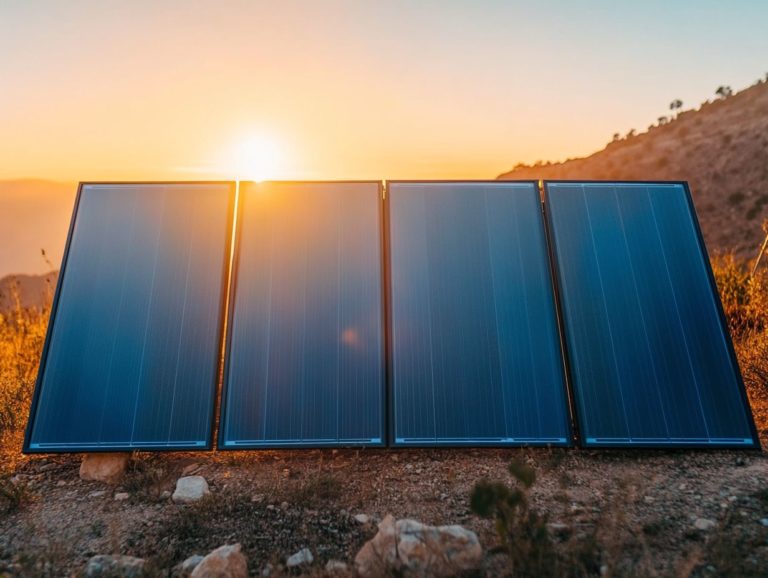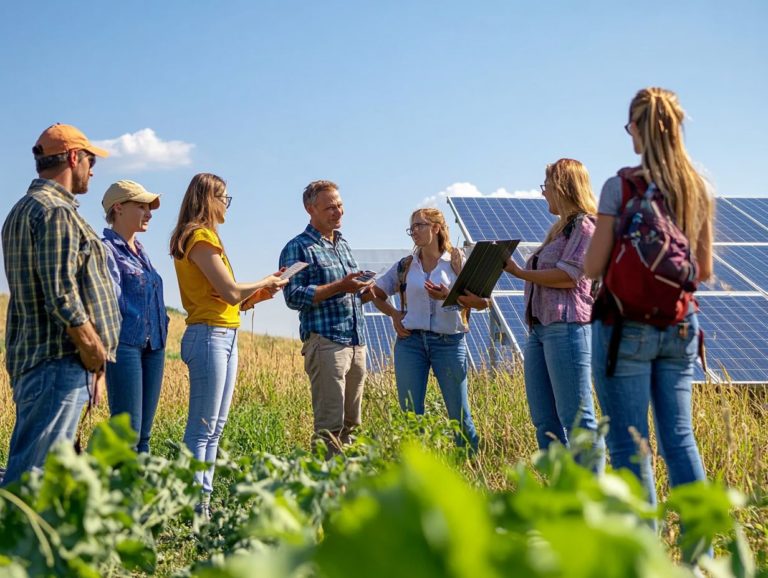What Types of Renewable Energy Are Available?
Renewable energy is changing how you power your life while tackling environmental challenges!
This article explores four key types: solar, wind, hydroelectric, and biomass energy. You’ll learn how these sources work and their unique pros and cons.
If you’re curious about tapping into the sun’s energy or excited about wind turbines, you’ll find valuable insights on the benefits and challenges of a sustainable future.
Contents
Key Takeaways:
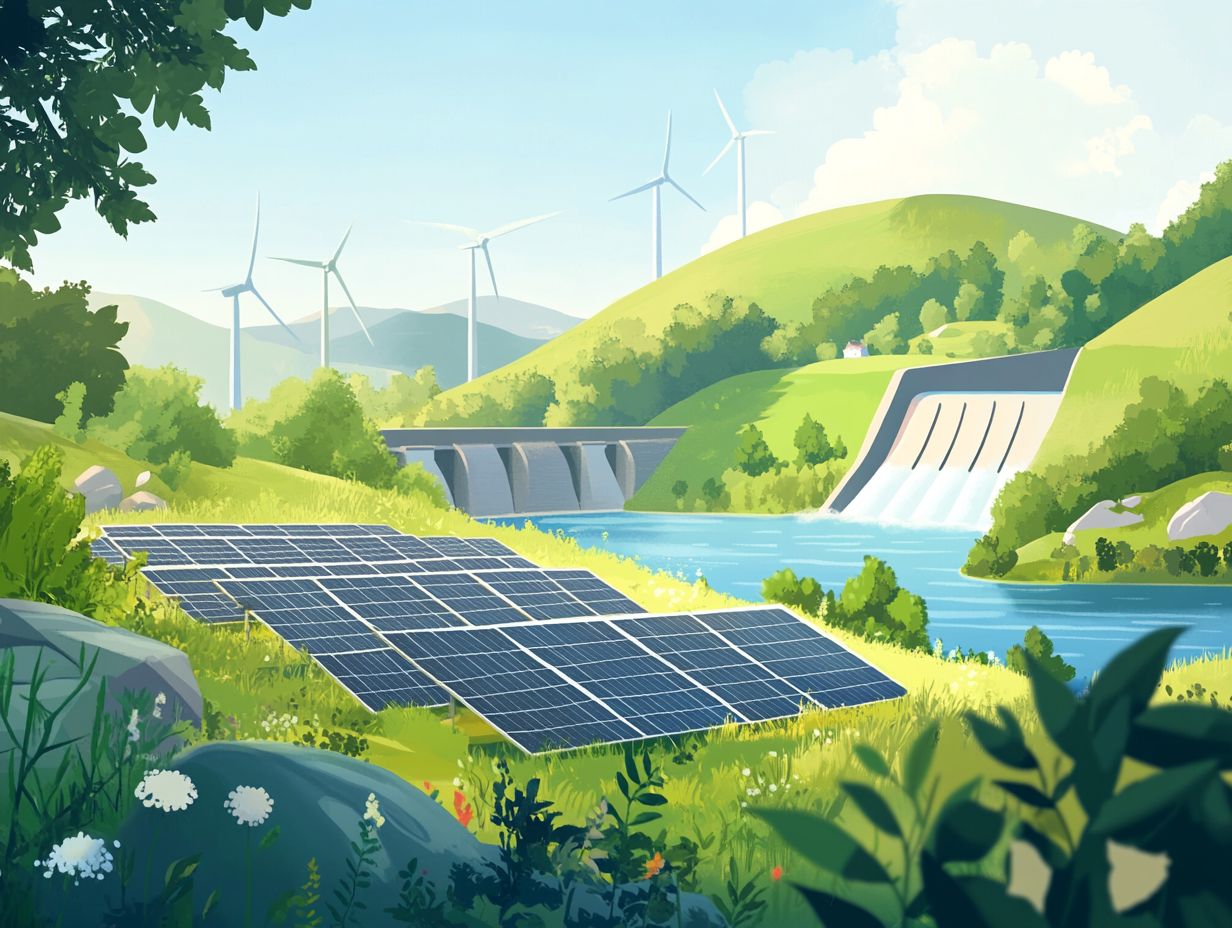
- Solar, wind, hydropower, and biomass energy are major renewable energy sources.
- Solar energy uses solar cells to convert sunlight into electricity, while wind energy captures wind with turbines.
- Each type has its advantages and disadvantages, such as cost, reliability, and environmental impact.
What is Renewable Energy?
Renewable energy comes from natural processes that keep replenishing, like sunlight, wind, and water. Unlike fossil fuels, which are finite, renewable sources help create a cleaner environment and reduce greenhouse gas emissions.
These sources are crucial in fighting climate change and boosting energy independence.
By shifting to renewable energy, we can reduce pollution and create jobs in the green sector. Using the sun, wind, and water lessens our dependence on imported fossil fuels and mitigates geopolitical risks.
Investing in renewable energy not only supports innovative technologies but also calls for governments to enforce effective policies that encourage this important transition.
Such policies can lead to better infrastructure, technological growth, and public awareness, ensuring a comprehensive approach to sustainable energy practices.
Solar Energy
Solar energy, harnessed from the sun, is one of the most accessible forms of renewable energy today. It’s particularly effective for electricity generation, thanks to solar panels that let us use this abundant resource sustainably.
How Solar Energy Works
Solar energy converts sunlight into electricity through solar cells, which are essential parts of solar panels. These cells use materials that absorb sunlight, causing electrons to flow and generate electricity.
This process provides a sustainable electricity source and reduces our reliance on fossil fuels, which are major contributors to greenhouse gas emissions.
By adopting solar power, you can significantly lower your carbon footprint and contribute to a cleaner planet.
Advantages and Disadvantages
The advantages of solar energy are plentiful, including its sustainability, long-term reduction in energy costs, and minimal environmental impact. This makes it a key contributor to the shift towards renewable energy sources.
However, challenges like initial investment requirements and variability in energy generation are important factors to consider.
Incorporating solar energy into your daily routine can greatly enhance energy efficiency. By harnessing sunlight, solar panels convert it directly into electricity, which can dramatically reduce your reliance on fossil fuels. Making this transition can help us dramatically cut greenhouse gas emissions and create a more resilient energy infrastructure.
It s also important to recognize that initial installation costs can be a barrier for many homeowners, and the need for sufficient land or roof space may limit accessibility.
Solar energy generation heavily depends on weather conditions, leading to fluctuations in energy production. While the potential benefits of renewable energy, like solar, are impressive, understanding the trade-offs involved is crucial for making well-informed decisions about energy consumption.
Wind Energy
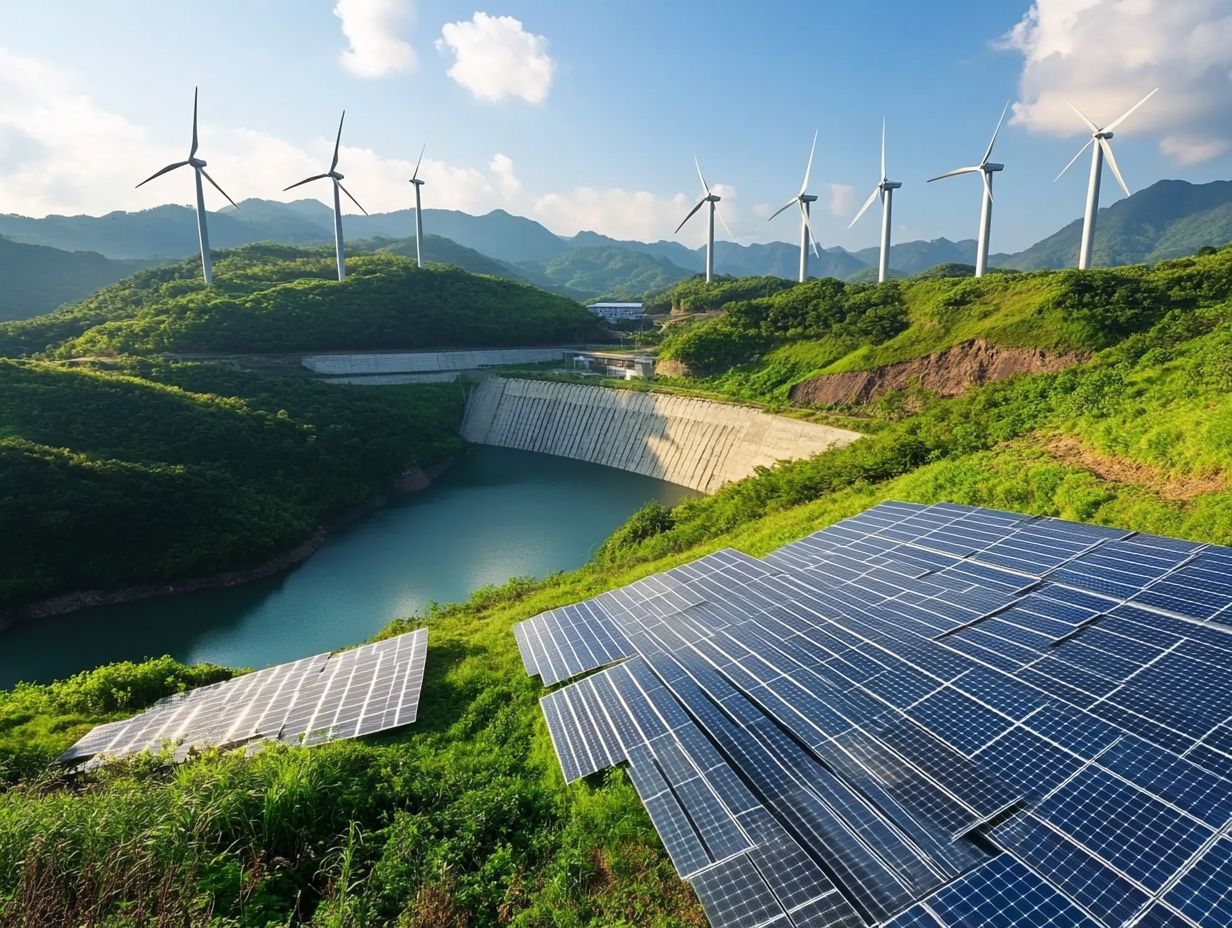
Wind energy is an exciting renewable resource that can power our future. It is harnessed through wind turbines that convert the energy from moving air into electricity, playing a crucial role in electricity generation and significantly diminishing our reliance on fossil fuels.
How Wind Energy Works
Wind energy operates using wind turbines that capture the energy from moving air, transforming it into mechanical energy, which is then converted into electrical energy for distribution throughout our electricity supply.
These turbines have large blades that rotate with the wind, driving a generator to produce electricity. As the wind speed changes, the turbine adjusts its position and blade angle to optimize efficiency, ensuring a steady output of energy.
This renewable source plays a significant role in creating a cleaner electricity grid, reducing our dependence on fossil fuels and lowering greenhouse gas emissions. By harnessing wind energy, we not only promote sustainability but also enhance energy security through a diverse energy mix, positioning wind as a vital component in the journey toward a greener future.
Advantages and Disadvantages of Wind Energy
Wind energy offers many advantages, such as sustainability, low operational costs, and a minimal environmental footprint. However, it’s essential to weigh the challenges, including noise, aesthetics, and the impact on wildlife.
By harnessing wind as a power source, we enhance energy efficiency and contribute to a diverse energy mix that reduces our dependence on fossil fuels. As communities seek to transition to renewable energy sources, wind energy stands out as a compelling option, promising cleaner air and lower greenhouse gas emissions.
While the benefits are indeed substantial, concerns about noise pollution from turbines can affect the quality of life for nearby residents. The visual impact of wind farms on the landscape highlights the need for thoughtful planning and active community engagement. Additionally, potential effects on local wildlife, including birds and bats, require ongoing research to ensure that our environmental integrity remains intact.
Hydroelectric Energy
Hydroelectric energy is one of the most established forms of renewable energy, harnessing the flow of water to produce electricity through hydroelectric power plants. This method plays a crucial role in global energy production, seamlessly blending tradition with sustainability.
How Hydropower Works
Hydropower is an impressive process that captures the potential energy of water stored in reservoirs and transforms it into electricity using turbines in hydroelectric power plants.
The journey begins when water from elevated sources cascades downward, driven by gravity. This movement sets the turbine blades into motion. As these turbines spin, they convert the kinetic energy of flowing water into mechanical energy, which is then transformed into electrical energy through generators.
What’s remarkable about this method is its efficiency; it often achieves conversion rates exceeding 90%. This positions it as one of the most productive forms of electricity generation available. Compared to fossil fuels and other energy sources, hydroelectric systems shine in sustainability and lower greenhouse gas emissions. They contribute to a cleaner environment while meeting energy demands and ensuring energy security.
Advantages and Disadvantages
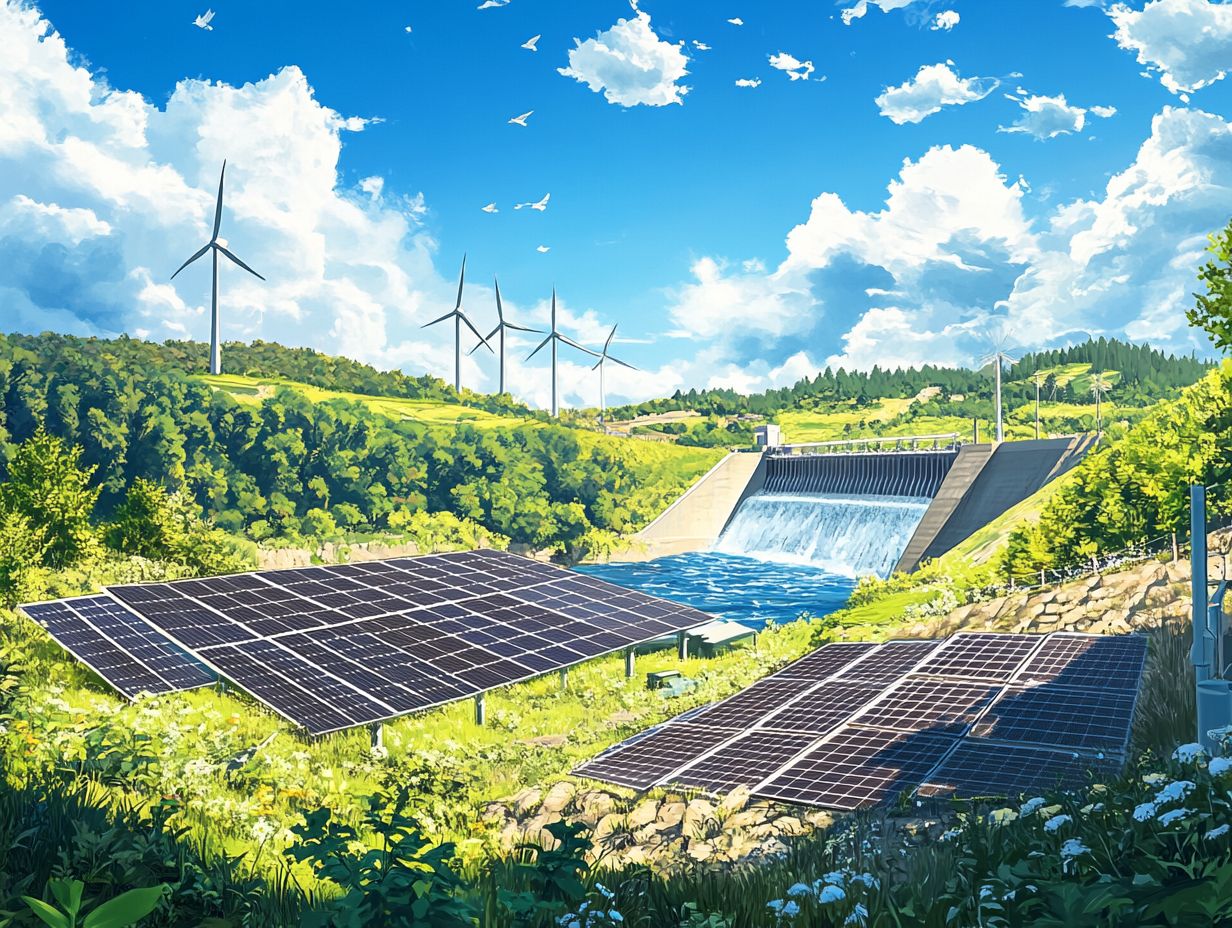
Hydropower offers many advantages, including clean energy production, flood control, and a reliable electricity supply. However, it also presents challenges, such as harm to wildlife and high initial infrastructure costs that can affect the transition to renewable energy.
Beyond these benefits, hydropower plays a crucial role in reducing greenhouse gas emissions, making it essential for the shift toward renewable energy sources. By leveraging the capabilities of flowing water, it guarantees consistent electricity generation that adapts to fluctuating demand.
Yet, the construction of dams and water diversion can lead to habitat loss and alterations in local ecosystems, raising sustainability concerns. The significant investments required to develop and maintain this infrastructure can deter potential projects, ultimately limiting growth in certain regions.
Biomass Energy and Bioenergy
Biomass energy comes from organic materials, including plant and animal waste. It’s recognized as a form of renewable energy, ideal for heating, electricity generation, and biofuels.
When managed sustainably, it plays a significant role in lowering carbon emissions, making it an essential, game-changing resource for a greener future.
How Biomass Energy Works
Biomass energy harnesses the power of organic materials, turning them into usable energy through techniques such as combustion, anaerobic digestion (a process where bacteria break down waste in the absence of oxygen), or fermentation. This ultimately results in biofuels or electricity generation.
This process involves breaking down organic substances like agricultural residues, wood chips, or even waste, which can be repurposed to meet diverse energy demands. During combustion, biomass burns to produce heat, generating steam that drives turbines for electricity.
In anaerobic digestion, microorganisms break down organic materials to produce biogas, usable for heating or further transformed into biofuels.
Fermentation converts sugars from biomass into ethanol, key for creating cleaner-burning fuels. The beauty of biomass energy lies in its ability to reduce dependence on fossil fuels, paving the way for a more sustainable and renewable energy future.
Advantages and Disadvantages
Biomass energy has compelling advantages. It offers effective waste management and generates energy from renewable sources.
It can also help reduce greenhouse gas emissions. However, be aware of the challenges it faces, such as competition for land and the necessity for sustainable practices.
By converting organic waste into energy, biomass not only alleviates landfill overflow but also diverts hazardous waste from the environment, showcasing its dual benefit.
This energy form plays a significant role in promoting a circular economy, a system where resources are reused and recycled, ultimately fostering sustainability.
Yet, with the increasing demand for biomass resources, there s a risk of excessive use, which raises concerns about deforestation and biodiversity loss.
Managing emissions is crucial to making the most of biomass energy! It’s vital to carefully manage the emissions from biomass energy production to avoid worsening air pollution.
Striking a balance between these benefits and challenges is crucial for ensuring the long-term viability of biomass as a sustainable energy solution.
Frequently Asked Questions
Here are some common questions about renewable energy.
What Types of Renewable Energy Are Available?
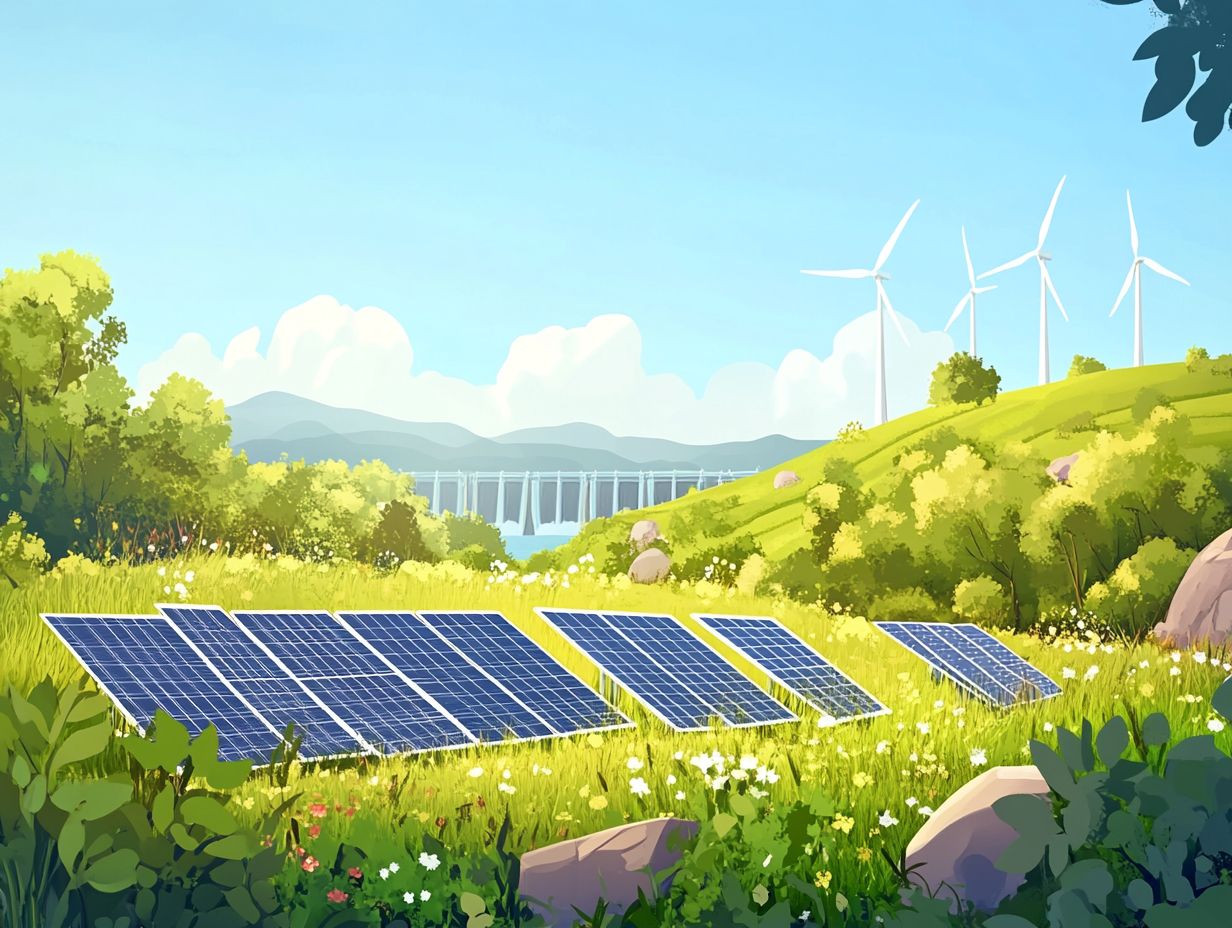
There are several types of renewable energy available, including solar, wind, hydro, geothermal, bioenergy, and tidal power. Understanding the types of renewable energy can help you make informed choices for a sustainable future.
What is solar energy?
Solar energy is a type of renewable energy that harnesses the power of the sun to generate electricity or heat water.
How does wind energy work?
Wind energy is generated by using wind turbines to capture the kinetic energy of the wind and convert it into electricity.
What is hydro energy?
Hydro energy, also known as water power, uses the power of moving water to generate electricity through turbines.
What is geothermal energy?
Geothermal energy uses the heat from the Earth’s core to generate electricity or heat buildings through the use of geothermal power plants or heat pumps.
What is bioenergy?
Bioenergy is the energy produced from organic materials, such as plants, animal waste, and other forms of biomass.




